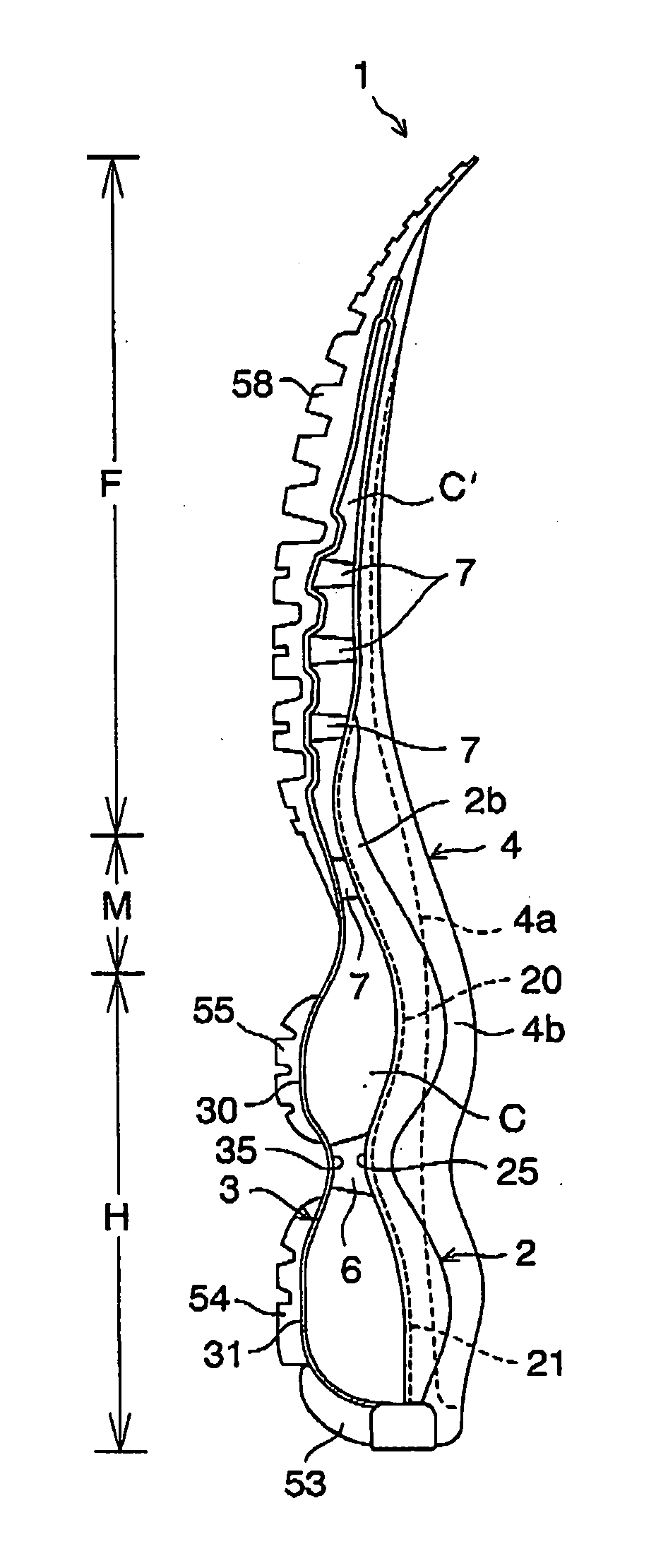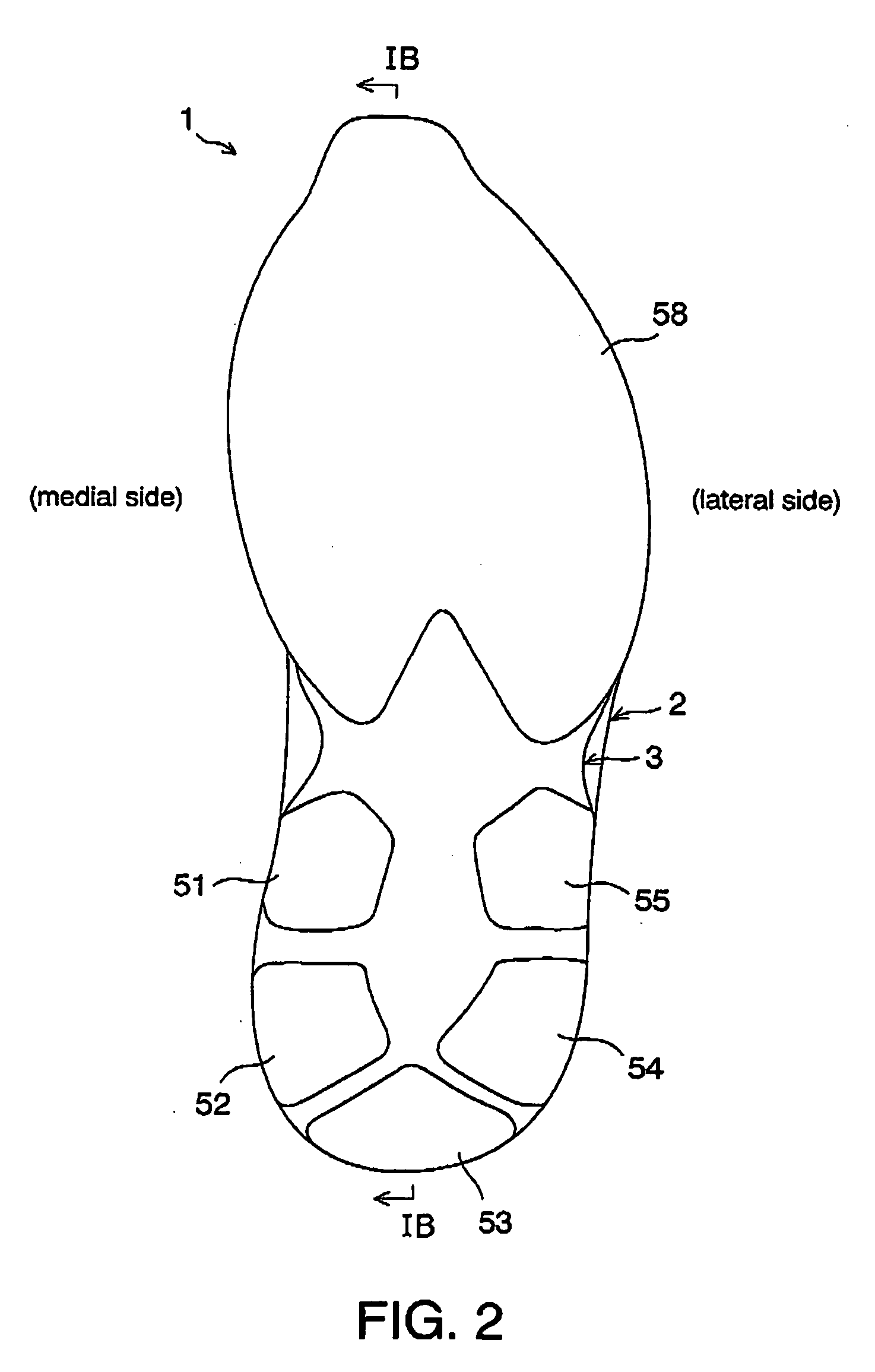Sole structure for a shoe
- Summary
- Abstract
- Description
- Claims
- Application Information
AI Technical Summary
Benefits of technology
Problems solved by technology
Method used
Image
Examples
first embodiment
[0060] Referring now to the drawings. FIGS. 1A and 1B show a sole structure or a sole assembly according to the present invention. As shown in FIGS. 1A and 1B, a sole structure 1 includes an upper plate 2 extending from a heel portion H through a midfoot portion M to the forefoot portion F of the sole structure 1, and a lower plate 3 disposed below the upper plate 2 and extending from the heel portion H through the midfoot portion M to the forefoot portion F similar to the upper plate 2. Both of the upper plate 2 and the lower plate 3 extend in the shoe width direction, and the front end edges of the plates 2, 3 are coupled to each other and rear end edges of the plates 2, 3 are also coupled to each other.
[0061] The upper plate 2 has wavy configurations that progress longitudinally in the heel portion H and that have two convex portions 20, 21 each protruding upwardly. The lower plate 3 has wavy configurations that progress longitudinally in the heel portion H similar to the upper p...
second embodiment
[0076]FIG. 3 shows a sole structure according to the present invention. In FIG. 3, like reference numbers indicate identical or functionally similar elements.
[0077] In the above-mentioned first embodiment, the upwardly convex portion 35 between the adjacent downwardly convex portions 30, 31 of the lower plate 3 is positioned against the downwardly convex portion 25 between the adjacent upwardly convex portions 20, 21 of the upper plate 2, whereas in the second embodiment, these convex portions 25, 35 are disposed offset in the longitudinal direction. Preferably, as shown in FIG. 3, the downwardly convex portion 25 of the upper plate 2 is disposed in front of the upwardly convex portion 35 of the lower plate 3. An elastic block 6 connecting the downwardly convex portion 25 of the upper plate 2 with the upwardly convex portion 35 of the lower plate 3 extends obliquely upwardly from the lower plate 3 to the upper plate 2.
[0078] In this case, at the time of striking onto the ground, th...
third embodiment
[0080]FIG. 4 shows the present invention. In FIG. 4, like reference numbers indicate identical or functionally similar elements.
[0081] This third embodiment differs from the second embodiment in that the upper and lower plate 2, 3 has a third convex portion 22, 32, respectively. The convex portions 22, 32 protruding in the opposite directions are contraposed in the vertical direction, and a third void C is formed between the convex portions 22, 32. The upwardly convex portion between the adjacent downwardly convex portions 31, 32 of the lower plate 3 is disposed opposite the downwardly convex portion between the adjacent upwardly convex portions 21. 22 of the upper plate 2. These oppositely disposed portions are connected to each other through the elastic block 61.
[0082] In this case, by forming the void C at the heel rear end portion, when impacting the ground on the heel rear end portion, downward deformation of the upper plate 2 becomes much easier, thereby further improving the...
PUM
 Login to View More
Login to View More Abstract
Description
Claims
Application Information
 Login to View More
Login to View More - R&D
- Intellectual Property
- Life Sciences
- Materials
- Tech Scout
- Unparalleled Data Quality
- Higher Quality Content
- 60% Fewer Hallucinations
Browse by: Latest US Patents, China's latest patents, Technical Efficacy Thesaurus, Application Domain, Technology Topic, Popular Technical Reports.
© 2025 PatSnap. All rights reserved.Legal|Privacy policy|Modern Slavery Act Transparency Statement|Sitemap|About US| Contact US: help@patsnap.com



